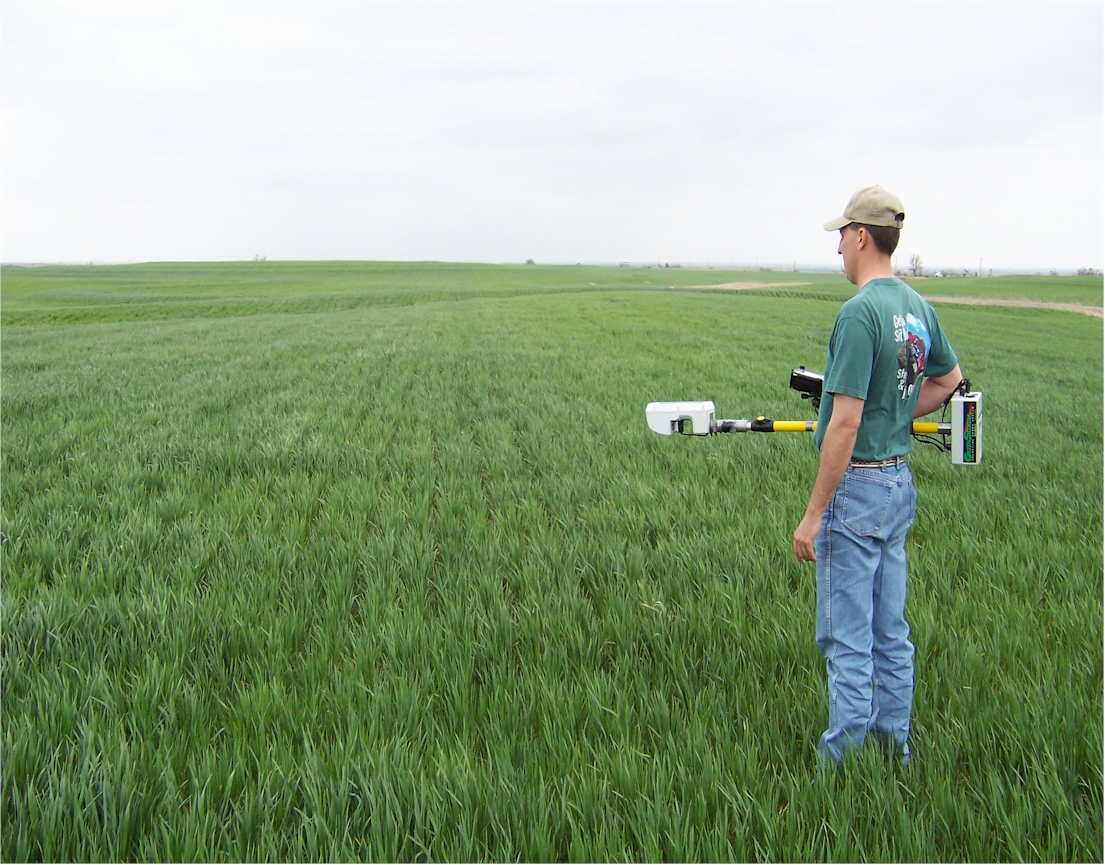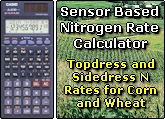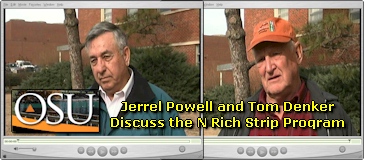_files/nitrogen_rich.jpg) Get Your Nitrogen-Rich Strips Out Early
Get Your Nitrogen-Rich Strips Out Early
Bill Raun, Hailin Zhang, John Solie and Marvin Stone
Departments of Plant & Soil Sciences and Biosystems and Ag Engineering
Division of Agricultural Sciences & Natural Resources
PT 2005-3 January 2005 Vol.17, No.3
 Nitrogen-Rich Strips replace
the use of yield goals for making mid-season fertilizer-N recommendations
Nitrogen-Rich Strips replace
the use of yield goals for making mid-season fertilizer-N recommendations
Maximum wheat yields vary greatly from year-to-year, and the amount of N that the environment delivers (essentially for free) changes even more. What is this free environmental N? After crops are planted, there is a lot of N that can be used by the plant that does not come from fertilizer. In general this free N comes from two sources, N mineralized from soil organic matter and that deposited in the rainfall. If conditions from planting to mid-season are warm and wet, the N mineralization (N in organic matter that becomes available) can lead to over 40 lbs N/ac made available to the crop. Up to an additional 20 lbs of N in the rainfall can lead to a total of over 60 lbs N/ac without ever applying any fertilizer. Alternatively, if conditions from planting to mid-season fertilizer N application are cool and dry, less than 20 lbs of N/ac will be delivered to your wheat crop from the environment (organic N and rainfall).
Nitrogen Rich Strips can tell you how much N the environment delivers, and when using our web-based Sensor Based Nitrogen Rate Calculator, we can tell you exactly how much additional mid-season fertilizer N should be applied to achieve maximum yields.
http://www.soiltesting.okstate.edu/SBNRC/SBNRC.php
How is this done? Using the GreenSeeker Hand-Held Sensors, actual wheat grain yields can be estimated using the NDVI readings (value output from the sensors) from the Nitrogen Rich Strip compared to the Farmer Practice, and knowing the date when the wheat was planted. Essentially, the NDVI value from the hand-held sensor outputs total biomass. For readings collected between January and March (regardless of when the wheat was planted), we can estimate biomass produced per day. This value is used to predict the wheat grain yield obtainable. With these numbers we can accurately predict both the yield and the need for additional N.
In some years, there will be minimal amounts of N needed, while in others there will be significant quantities required for maximum yield. Why should we apply the same rate each year when the yields are different? Why should we apply the same rate each year when the environment delivers (for free) totally different amounts and that impact the rate required from mid-season N applications.

In the picture above, Jason Lawles inspects the Nitrogen Rich Strip (left) compared to the normal farmer practice (right). In this case, the NDVI reading on the left was 0.75, and the NDVI reading on the right was 0.61. The response index of 1.23 (0.75/0.61 = 1.23) indicates that we could achieve a 23% increase in yield if added N fertilizer is applied. The topdress N rate is determined by computing N uptake in the N Rich Strip minus N uptake in the farmer practice, divided by an efficiency factor. All of this is done automatically on the SBNRC web site (listed above) and that reports both the projected wheat grain yields (based on these readings and when the crop was planted) and the optimum topdress fertilizer N rate.
Even if you do not have access to a GreenSeeker Hand-Held sensor, you need to apply your Nitrogen Rich Strip preplant (or soon thereafter) in each and every field, and to use the difference between the Nitrogen Rich Strip and your conventional practice to determine how much N the environment delivered and whether or not you should apply fertilizer N. If you cannot see the difference between the Nitrogen Rich Strip and your conventional practice (visual interpretation from January to March), you are unlikely to obtain any benefit from mid-season fertilizer N.
What we do know is that the amount of N required from one year to the next changes drastically. Our long-term experiments clearly show that in some years, less than 20 lbs of fertilizer N/ac can be required for maximum yields, while in others 120 lbs of N/ac is needed. Furthermore, if excess N is applied one year, it has limited impact on the demands for N the subsequent year. In other words, we need to re-determine the mid-season fertilizer N rate each and every year.
How much N should I apply preplant for my Nitrogen Rich Strip?
Grain Yield N Rich Strip
20 50
30 75
40 100
50 125
60 150
70 175
The amount of N in the soil test (NO3-N) should be subtracted from these recommended amounts. If you have a forage + grain production system, these preplant N rates for your N Rich Strip should be increased by 20 to 30%. There is no fixed recommendation, but rather you should use common principals to arrive at a rate where N will not be limiting throughout the season. Farmers are not going to take the risk of applying the rate for a N Rich Strip to their entire field, simply because on average it will not pay. What the N Rich Strip does is it serves as a guide to how much topdress N should be applied to maximize yields, taking into account how much the environment delivered for free.
What if I did not get the N Rich Strip out Preplant?
Putting out your N Rich Strip as late as the end of December is probably OK, but the best mid-season fertilizer N rates are going to be determined from N Rich Strips that were put out at planting or soon thereafter.
Where should I put the N Rich Strip?
In general, we recommend placing the N Rich Strip in the middle of the field, applied over the entire length. Also, the starting point should be somewhere close to a drive-by road, thus allowing visual inspection on a daily basis.
Where do I go with Questions?
You can consult our Nitrogen Use Efficiency Web site (www.nue.okstate.edu) or you can give us a call at OSU.
http://www.nue.okstate.edu/Index_RI.htm
What can I expect from Using this Technology?
This method will allow you to determine the ideal topdress N rate. Over
the years we have seen that this is worth over $10.00 per acre. All you
have to do is put out your N Rich Strip and use it as a guide for mid-season N
fertilization.
---------------------------------------------------------
Oklahoma State University, in compliance with Title VI and Vii of the Civil Rights Act of 1964, Executive Order 11246 as amended, Title IX of the Education Amendments of 1972, Americans with Disabilities Act of 1990, and other federal laws and regulations, does not discriminate on the basis of race, color, national origin, sex, age, religion, disability or status as a veteran in any of its policies, practices or procedures. This includes but is not limited to admissions, employment, financial aid, and educational services.
Issued in furtherance of Cooperative Extension work, acts of May 8 and June 30, 1913, in cooperation with the US Department of Agriculture, Sam E. Curl, Director of Oklahoma Cooperative Extension Service, Oklahoma State University, Stillwater, Oklahoma. This publication is printed and issued by Oklahoma State University as authorized by the Dean of the Division of Agricultural Sciences and Natural Resources.
Click on the Question to See the VIDEO.Tom Denker, Farmer near Enid, OK
Question: What is the benefit of GreenSeeker Technology?
Question: What do you think about OSU working with private industry to make this type of technology available to producers?
Question: Would you like to add anything?
Jerrel Powell, Farmer near Council Hill, OK
Question: How have you used GreenSeeker
Technology?
Question: Why is Nitrogen Important?
Question: What would you like to tell
producers in OK about GreenSeeker Technology?

